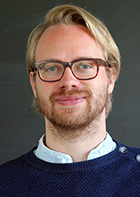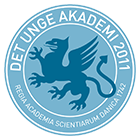Another mathematician admitted to the Young Academy
The Young Academy has just approved seven new members, all of whom are excellent young researchers in their respective fields of study. One of these is Niels Martin Møller, assistant professor at the Department of Mathematical Sciences.

Niels Martin Møller
The academy writes in a press release that the seven new members will bring new ideas and perspectives into a dynamic academy in rapid development.
The seven new members carry out research in very different areas: DNA, algorithmics, disasters, language cultures, vegetation dynamics and material structure on an atomic scale.
Niels Martin Møller's research field is geometric analysis, which is the study of the differential equations that are associated with the understanding of spatial forms. In particular, it is the theory of optimal geometric shapes which currently interests him.
Minimal surfaces
- I work with minimal surfaces, which are - slightly simplified - spatial divisions with the least possible area under the given conditions. It's something nature often produces, so the beautiful minimal structures appear in such different places as in colored bird feathers, in the staircase DNA structure of the cells and even on the edge of the black holes of the universe, Niels Martin Møller says.
- Related to the surfaces are the so-called "curvature flows", which can be thought of as dynamic processes; as time passes, the space searches to find such 'best possible' surfaces.
- I am also very interested in theoretical physics, and here, there are many interesting and very tangible links to the topics. The well-known equations for both electric fields, the quantum mechanical spring, and for other more complicated systems, emerge again and again in the work of my, perhaps slightly abstract, geometric issues.
Maintaining Denmark as a knowledge society
- In the Young Academy, I want to participate in initiatives that can increase public awareness of talent and proffesionalism. It may start with increasing the visibility of for example natural science, my own main area of interest. One must also ensure that the conditions offered in Denmark to the pool of talent will be excellent, says Niels Martin Møller.
- More specifically, I hope that we can stick to the promises about investing in Denmark as a knowledge society, with a solid base in fundamental research and with good, stable conditions for researchers. It is widely recognized that it is the synergy and culture in the science community as a whole that lead to the inventions that we all have benefit from.
 The Young Academy
The Young Academy
Behind the Young Academy is the Royal Danish Academy of Sciences and Letters. They created the academy in autumn 2011 as an independent platform for young researchers in all fields of science.
The current 41 members include a quantum physicist, a historian of ideas, several chemists, a few anthropologists, some biologists, a theologian - and now two mathematicians, both from the Department of Mathematical Sciences at the University of Copenhagen.
The purpose of the academy is to strengthen basic research and interdisciplinary exchange, bridge the gap between science and society - and give some of the country's most talented young researchers a public voice. Members are all high-profile researchers with considerable international experience and interesting views on research and society.
Members are awarded a five-year membership, based on a written application followed by an interview. There are approximately eight new members each year.
